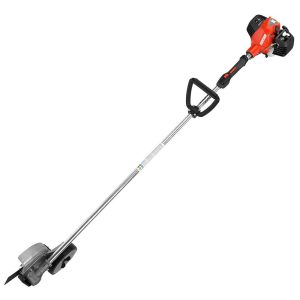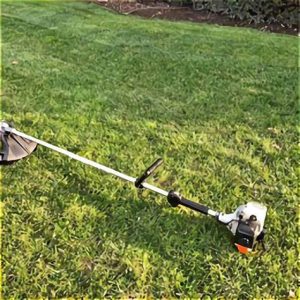12 Reasons Your ECHO Leaf Blower Won’t Start SOLVED!
A leaf blower is a great tool that can be used for many different tasks. It not only blows leaves but it can also be used to clean off your deck, dry your lawn mower and even blow off light snow from your vehicles and sidewalk. When it doesn’t start, it can be pretty inconvenient.
An ECHO leaf blower will not start when the air filter is plugged, the spark plug is bad, the carburetor is dirty, old fuel gummed up the fuel system, an incorrect fuel mix is used, the recoil starter is bad, or the engine is flooded.
Follow all safety precautions in your ECHO operator’s manual to avoid injury while working on your leaf blower. When I start troubleshooting a blower that doesn’t start, I replace the air filter, fuel filter, and spark plug. That way I can rule out a routine maintenance part as being part of the problem.

This post may include affiliate links. Purchases made through these links may provide a commission for us, at no extra cost to you. As an Amazon Associate, we earn from qualifying purchases.
Follow all safety instructions provided in your equipment operator’s manual prior to diagnosing, repairing, or operating.Consult a professional if you don’t have the skills, or knowledge or are not in the condition to perform the repair safely.
Table of Contents
12 Reasons Your ECHO Leaf Blower Won’t Start
Plugged Air Filter in an ECHO Leaf Blower
The air filter keeps dirt and debris from entering the engine and causing damage. When the filter isn’t routinely changed to keep it clean, it can become plugged preventing air from getting to the engine. Without air, the ECHO leaf blower will not start and run.
Never operate your leaf blower without an air filter, even if it is just for a short period so you can finish a task. Dirt in the engine can cause significant engine damage which may result in having to buy a new blower.
Remove the filter and wipe out any remaining dirt from the air filter housing. Replace a dirty air filter with a new air filter.
Bad Spark Plug in an ECHO Leaf Blower
A bad spark plug is one that is dirty with carbon buildup, has cracked porcelain, or has a burnt electrode. When the plug isn’t functioning, it will not provide the spark required for the engine to run.
Remove the spark plug and inspect it. Replace a dirty or damaged spark plug with a new one. The spark plug must be gapped at .024″-.026″.
Plugged Fuel Filter in an ECHO Leaf Blower
The fuel filter keeps dirt from entering the fuel system by straining fuel coming out of the fuel tank. If the filter is plugged, fuel will be prevented from passing through the filter so the engine can’t get the fuel it requires to start.
Replaced a plugged fuel filter with a new filter. You will find the filter located inside the fuel tank. Wipe around the fuel cap to prevent dirt from falling into the tank before removing the cap.
Use a clean bent wire to hook the fuel line and pull out the filter. Use a pair of needle nose pliers to grip the fuel line and pull the filter out of the line. Replace with a new filter.
Incorrect 2-Cycle Oil Mix in an ECHO Leaf Blower
Using straight gas in an ECHO leaf blower will damage the engine and cause it to seize up. Adding straight gas to your blower is a quick way to ruin it. The 2-cycle engine in an ECHO leaf blower uses gas and oil mixed at a ratio of 50:1.
When creating this mix, use unleaded gasoline with a minimum octane rating of 89 (mid-grade) and maximum ethanol content of 10%. Mix a 2-cycle premium oil like ECHO PowerBlend Oil with the gasoline.
50:1 = 1 gallon of gas + 2.6 fl oz. ECHO PowerBlend Oil or Red Armor Oil
50:1 = 2.5 gallons of gas + 6.4 fl oz ECHO PowerBlend Oil or Red Armor Oil
You can also use an equivalent 2-cycle oil that is ISO-L-EGD and JASO M345 FD certified.
A great option to reduce fuel problems and extend engine life is the Pre-Mixed ECHO Red Armor fuel. This is an ethanol-free blend of oil and fuel that is ready to pour into your leaf blower’s fuel tank.
You won’t have to deal with the bad effects of ethanol as discussed in the next section.
Old Fuel and Oil Mix in an ECHO Leaf Blower
Ethanol, found in most types of gasoline on the market today, attracts moisture to the fuel system. This water and ethanol mixture causes gumming in the fuel system and degrading of its components.
It contributes to premature failure of the fuel components and blockages preventing the engine from getting the fuel it requires.
Additionally, water and ethanol separate from the gasoline and sink to the bottom of the fuel tank. When this solution runs through the engine, it runs hot and can damage the engine.
Always use unleaded gasoline with a maximum ethanol content of 10% (E10). Avoid E15 and E85 gasoline. Drain any old fuel remaining in your leaf blower and fill it with fresh gas and oil mix.
Add a fuel stabilizer like Sea Foam Motor Treatment to stabilize the fuel, clean the fuel system and reduce moisture in the fuel. If you choose to use a pre-mixed ethanol-free fuel, you do not need to add a stabilizer.
Bad Primer Bulb in an ECHO Leaf Blower
A cracked primer bulb that won’t fill up with fuel won’t function correctly to get fuel to the carburetor. Replace with a new primer bulb.
Fuel Line Blocked in an ECHO Leaf Blower
Old fuel sitting in your ECHO leaf blower can leave a gummy sticky deposit behind that restricts fuel flow. Replace a fuel line in the leaf blower when it is cracked, kinked, or clogged.
Plugged Fuel Tank Vent on an ECHO Leaf Blower
The fuel tank vent allows air into the tank. Without a vent, the fuel tank will create a vacuum that won’t allow fuel to flow through the ECHO blower.
A good indication you may have a fuel tank vent problem is when your leaf blower runs for a few minutes and then shuts down and won’t start until you remove the fuel cap to allow air into the fuel tank.
It then shuts down again after running for several minutes with the fuel cap in place. Replace the fuel tank vent so the air can flow into the fuel tank. Access the fuel tank vent attached to the fuel line coming out of the fuel tank.
Remove the fuel tank vent and replace it with a new fuel tank vent. Be careful you don’t lose the ring clip around the fuel line. This is needed to secure the tank vent to the fuel line.
Clogged & Dirty Carburetor on an ECHO Leaf Blower
The carburetor regulates the amount of fuel that is mixed with air to create a combustion in the cylinder. Old fuel will gum up and clog the carburetor so it no longer functions as designed.
If you are a little mechanical you should be able to handle cleaning your carburetor. Clean the carburetor by taking it apart and using carburetor cleaner to clean it.
If the carburetor does not function after being cleaned, you may need to rebuild it or replace it with a new carburetor. Carburetors for an ECHO leaf blower typically run between $60-$85.
Bad Recoil Starter on an ECHO Leaf Blower
Your ECHO leaf blower uses a recoil to start the engine. A bad pulley; loose or missing spring; or broken clips can keep your recoil from working.
You can attempt to replace the spring and restring the recoil. If it does not work because other components in your recoil are damaged, such as the clips or the pulley, you are better off just replacing the recoil assembly.
Bad Spark Arrestor in an ECHO Leaf Blower
The spark arrestor is a small screen that can get plugged with soot. A plugged spark arrestor may prevent your ECHO leaf blower from starting.
Remove the spark arrestor and clean it with a wire brush. If you are unable to clean it sufficiently, replace it with a new spark arrestor.
Flooded ECHO Leaf Blower
I have had customers bring their ECHO leaf blower to the repair shop because they can’t get it started. Many times it’s due to a flooded engine which isn’t too serious. The engine can become flooded when the choke is in the closed position and the starter rope was pulled many times.
It can also happen with the switch off and the starter rope being pulled multiple times or when the primer bulb is pushed too many times.
How to Fix a Flooded Engine on an ECHO leaf blower
- Turn the switch on to the run position.
- Move the choke lever to the run position.
- Press the throttle trigger while pulling the starter rope over and over. This can take anywhere between 5 and 15 pulls before it starts. Your leaf blower engine will sputter first. Continue to pull 2 to 3 more times and it should start.







